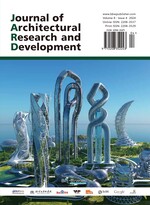Abstract
Green space, as a medium for carrying out urban functions and guiding urban development, is becoming a scarce resource along with the urbanization process and the intensification of environmental problems. In the face of the spatial mismatch between high demand and low supply, it is of great significance to clarify the evolution mechanism of green space to undertake national spatial planning, protect the natural strategic resources in the urban fringe area, and promote the sustainable development of the “three living spaces.” The study focuses on the Zunyi City Center, selecting the 20 years of rapid development following its establishment as a city as the study period. It explores the dynamic evolution of green space and the main driving forces during different periods using remote-sensing image data. The study shows that from 2003 to 2023, the total scale of green space has an obvious decreasing trend along with the expansion of the urban built-up area. A large amount of arable land is being converted to construction land, resulting in a sudden decrease in arable land area. In the past 10 years, the comprehensive land use dynamics have accelerated. Still, the spatial difference has gradually narrowed, indicating that the overall development intensity of Zunyi City’s central urban area has increased. There is a gradual spread of the trend to the hilly areas. The limiting effect of the mountainous natural environment on the city’s development has gradually diminished under the superposition of external factors, such as economic development, industrial technological upgrading, and policy orientation so the importance of the effective protection and rational utilization of urban green space has become more prominent.
References
Sun X, 2023, Basic Considerations of “Three Zones and Three Lines” in the National Spatial Planning System. Urban Planning, 47(06): 51–56 + 88.
Andren H, 1994, Effects of Habitat Fragmentation on Birds and Mammals in Landscapes with Different Proportions of Suitable Habitat: A Review. Oikos, 71(3): 355.
Sullivan WC, Jiang B, 2024, Urban Green Space as a Force for Change: Global Wisdom and Chinese Perspectives. Chinese Garden, 40(01): 6–13.
Peschardt KK, Stigsdotter UK, 2013, Associations between Park Characteristics and Perceived Restorativeness of Small Public Urban Green Spaces. Landscape and Urban Planning, 112: 26–39.
Peschardt KK, Schipperijn J, Stigsdotter UK, 2012, Use of Small Public Urban Green Spaces (SPUGS). Urban Forestry and Urban Greening, 11(3): 235–244.
Saphores JD, Li W, 2012, Estimating the Value of Urban Green Areas: A Hedonic Pricing Analysis of the Single Family Housing Market in Los Angeles, CA. Landscape and Urban Planning, 104(3/4): 373–387.
Yang Z, Zhang H, Ding Y, et al., 2015, Content and Prospect of Urban Green Space Research. Progress in Geoscience, 34(1): 18–29.
Tao Y, Li F, Wang R, et al., 2016, Research Progress on Quantitative Methods of Urban Green Space Pattern. Journal of Ecology, 33(8): 2330–2342
Xu XG, Duan XF, Sun HQ, et al., 2011, Green Space Changes and Planning in the Capital Region of China. Environmental Management, 47(3): 456–467.
Li F, Jie S, Li X, 2018, Research on the Spatiotemporal Evolution of Green Space in the Central City of Beijing Based on Multi-Source Data Analysis (1992–2016). Landscape Architecture, 25(08): 46–51.
Ministry of Natural Resources of the People’s Republic of China, 2017, Organized according to Classification of Land Use Status, GB/T21010-2017.
Ministry of Construction of the People’s Republic of China, 2018, Urban Green Space Classification Standard, CJJ/T85-2020.
Zhu H, Li X, 2003, Discussion on the Methodology of Regional Land Use Change Index Modeling. Journal of Geography, 58(5): 643–650.
Zhang L, Yang G, Liu J, 2014, Analysis of Land Use Dynamic Changes and Hotspots in Fushun City from 1986 to 2012. Journal of Geography, 34(2): 185–191.
Construction Committee of Zunyi City, 1993, Urban Construction Annals of Zunyi City, Zunyi People’s Publishing House, 1993: 1176–1989.
Lin J, Song M, Zhang A, 2018, Functional Positioning and Implementation Analysis of National Spatial Planning. China Land, 4(01): 15–17.
Zhang T, 2014, The Coordination Role of Planning and the Challenges Faced by Chinese Planning. Urban Planning, 38(01): 35–40.
